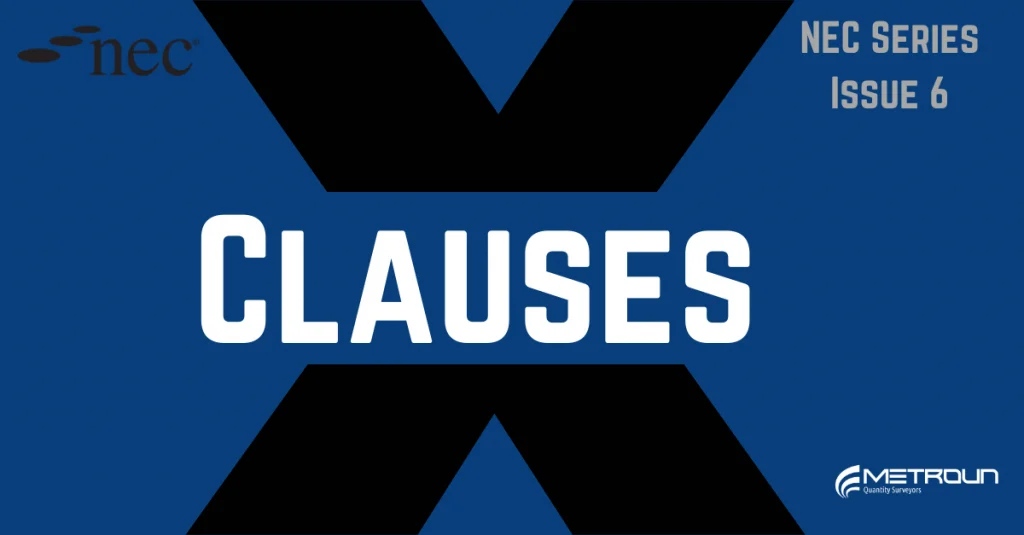The NEC Engineering and Construction Contract (ECC) contains an array of core and optional clauses. These clauses are used to develop the terms and conditions of a particular construction contract. The contract is then used as a framework to administer the design and/or build and/or maintenance of a project. The clauses fall under the following categories:
1. Core Clauses – these clauses are the bread and butter of the construction contract. Although often amended slightly to suit the client’s requirements. It’s recommended these are left mostly untouched so the aims and objectives of the NEC are upheld.
2. Main Option Clauses (A,B,C,D,E, F & W) – To supplement the Core Clauses, a Main Option Clause must be selected. This will determine how risk is shared between parties and by what means the contractor is reimbursed. You can find our article and video on these clauses here
3. Secondary Option Clauses (X,Y & Z) – These are optional bolt on clauses which can be implemented into a contract. X & Y being a selection of pre-written clauses and Z clauses which are completely customisable prior to contractual agreement.

Please click here for our selection of NEC tailored excel templates for download.
This article forms part of a trilogy which explores the Secondary Option Clauses in the NEC4. This segment will focus on X Clauses. What they are, and what they are used for.
The NEC4 X clauses are as follows:
Option X1: Price adjustment for inflation (Used only with option A,B,C & D) – This clause provides the means for adjusting the price of works. By factoring the base index (when prices were set) against the latest index, forming the PAF
Option X2: Changes in the law – Allowance for a compensation event, should a change in law occur after the Contract Date
Option X3: Multiple currencies (used only with options A & B) – This is used where the contractor is paid in currencies other than the currency of the contract
Option X4: Ultimate holding company guarantee – Used as a guarantee to the Client of the Contractor’s performance when the Contractor is a subsidiary of another company
Option X5: Sectional completion – Used when completion of works may mean a section of works, rather than the whole of the works
Option X6: Bonus for early completion – Monetary incentive for contractor finishing ahead of time
Option X7: Delay damages – Monetary disincentive for contractor finishing late
Option X8: Undertakings to the client or others – When the Contractor gives undertakings to Others as stated in the Contract Data
Option X9: Transfer or rights – When the Client owns the Contractor’s right over material prepared for the design of the works
Option X10: Information Modelling – Used when there is electrical integration of Project Information
Option X11: Termination by the client – Provides the Client with the rights to terminate the Contractor’s obligation to Provide the Works
Option X12: Multiparty collaboration (not used with Option X20)– Used when there are multiple parties or partners who have a contract in connection with the subject matter of the contract. In essence, multiparty collaboration
Option X13: Performance bond – Client insurance against the contractor failing to fulfil contractual obligations. Issued by either an insurance company or the bank
Option X14: Advanced payment to the contractor – Used when there is advanced payment agreements between Contractor and Client
Option X15: The contractor’s design – Used when the contractor is carrying out their own design
Option X16: Retention (not used with option F) – Used as insurance to the Client for works defects. Retention is a percentage of money retained from the contractor until completion of the works.
Option X17: Low performance damages – If a defect is linked to low performance (by the Contractor) and this clause is enacted, the Contractor pays the amount of low performance damages stated in the contract data
Option X18: Limitation of liability – This clause gives grounds for the limitation of Contractor’s liability to the Client for certain events which cause loss to the Client.
Option X20: Key performance indicators (not used with option X12) – Used as incentives for the Contractor to meet a certain level of performance stated in the Incentive Schedule.
Option X21: Whole life cost – Used when Client’s want Contractor’s to propose revisions to the Scope in order to reduce the cost of operating and maintaining an asset
Option X22: Early contractor involvement (used only with Options C and E) – Allows contractor involvement into a project before a full design or price has been established, enabling the contractor to take part in design development and construction at the planning stage.
Looking for NEC Training?
Metroun Learning is a revolutionary platform that maximises the knowledge and skillset of Quantity Surveyors.
We provide concise, easy-to-understand, information-packed courses (updated every month) that can fit into any busy workday.
Click here to find out more.





